2004 SUBARU IMPREZA engine
[x] Cancel search: enginePage 5 of 491

2
How to use this owner’s manual !Using your Owner’s manual
Before you operate your vehicle, carefully read this
manual. To protect yourself and extend the service life
of your vehicle, follow the instructions in this manual.
Failure to observe these instructions may result in se-
rious injury and damage to your vehicle.
This manual is composed of fourteen chapters. Each
chapter begins with a brief table of contents, so you
can usually tell at a glance if that chapter contains the
information you want.
Chapter 1: Seat, seatbelt and SRS airbags
This chapter informs you how to use the seat and seat-
belt and contains precautions for the SRS airbags.
Chapter 2: Keys and doors
This chapter informs you how to operate the keys,
locks and windows.
Chapter 3: Instruments and controls
This chapter informs you about the operation of instru-
ment panel indicators and how to use the instruments
and other switches.
Chapter 4: Climate Control
This chapter informs you how to operate the climate
control.
Chapter 5: Audio This chapter informs you how to operate your audio system.
Chapter 6: Interior equipment
This chapter informs you how to operate interior
equipment.
Chapter 7: Starting and operating
This chapter informs you how to start and operate your SUBARU.
Chapter 8: Driving tips
This chapter informs you how to drive your SUBARU
in various conditions and explains some safety tips on
driving.
Chapter 9: In case of emergency
This chapter informs you what to do if you have a prob-
lem while driving, such as a flat tire or engine over-
heating.
Chapter 10: Appearance care
This chapter informs you how to keep your SUBARU
looking good.
Chapter 11: Maintenance and service
This chapter informs you when you need to take your
SUBARU to the dealer for scheduled maintenance
and informs you how to keep your SUBARU running
properly.
Chapter 12: Specifications
This chapter informs you about dimension and capac-
ities of your SUBARU.
Page 8 of 491
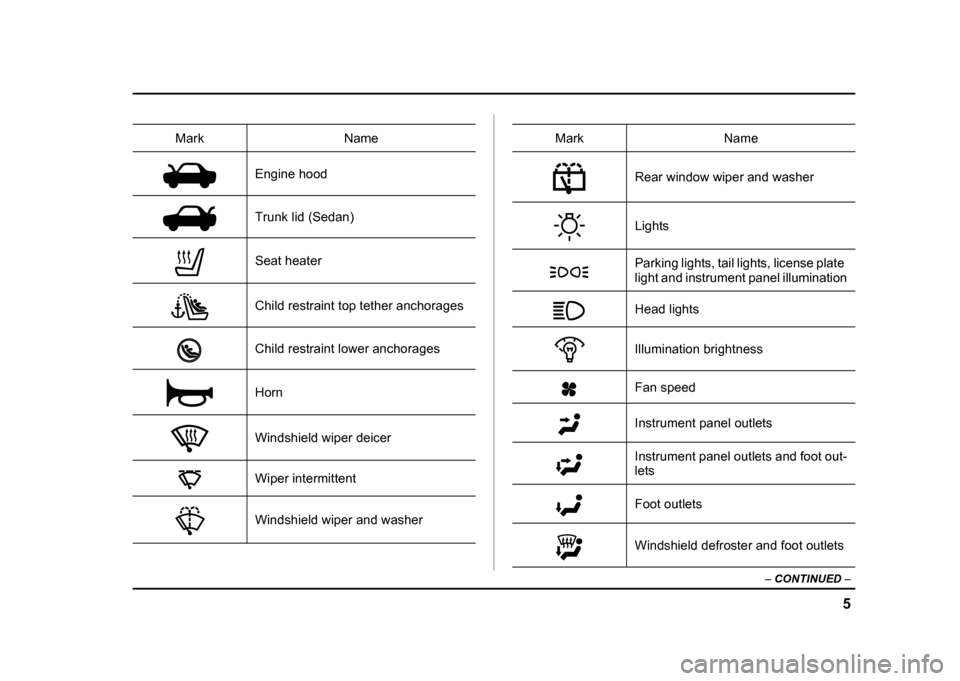
5
–
CONTINUED –
Engine hood
Trunk lid (Sedan)
Seat heater
Child restraint top tether anchorages
Child restraint lower anchorages
Horn
Windshield wiper deicer
Wiper intermittent
Windshield wiper and washer
Mark NameRear window wiper and washer Lights
Parking lights, tail lights, license plate
light and instrument panel illumination
Head lights
Illumination brightness
Fan speed
Instrument panel outlets
Instrument panel outlets and foot out- lets
Foot outlets
Windshield defroster and foot outlets
Mark Name
Page 9 of 491
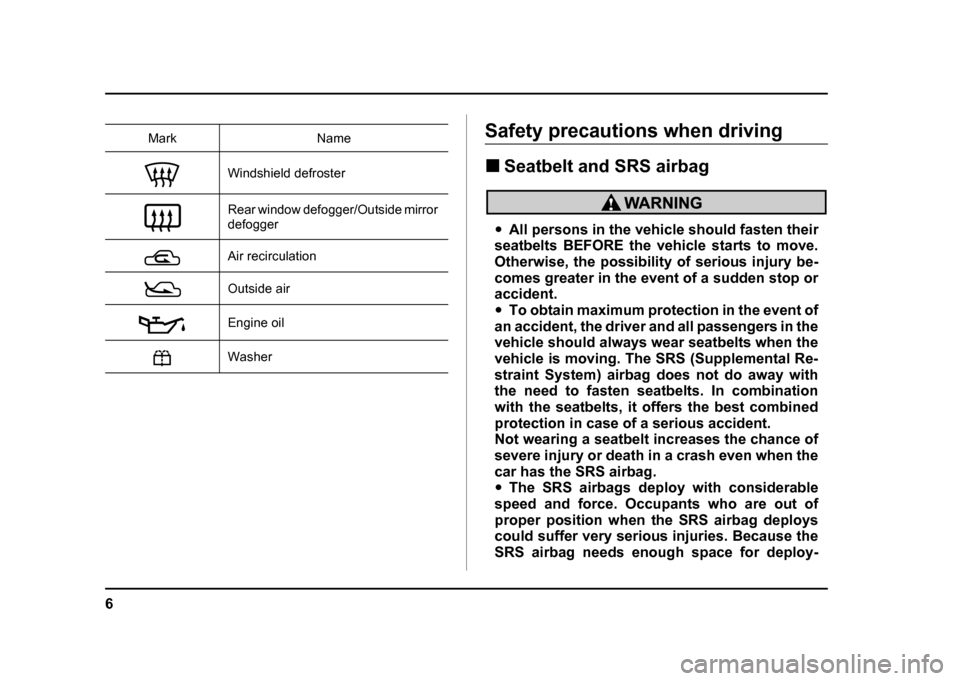
6
Safety precautions when driving !Seatbelt and SRS airbag
"All persons in the vehicle should fasten their
seatbelts BEFORE the vehicle starts to move.
Otherwise, the possibility of serious injury be-
comes greater in the event of a sudden stop or
accident. " To obtain maximum protection in the event of
an accident, the driver and all passengers in the
vehicle should always wear seatbelts when the
vehicle is moving. The SRS (Supplemental Re-
straint System) airbag does not do away with
the need to fasten seatbelts. In combination
with the seatbelts, it offers the best combined
protection in case of a serious accident.
Not wearing a seatbelt increases the chance of
severe injury or death in a crash even when the
car has the SRS airbag. " The SRS airbags deploy with considerable
speed and force. Occupants who are out of
proper position when the SRS airbag deploys
could suffer very serious injuries. Because the
SRS airbag needs enough space for deploy-
Windshield defroster
Rear window defogger/Outside mirror
defogger
Air recirculation
Outside air
Engine oilWasher
Mark Name
Page 11 of 491
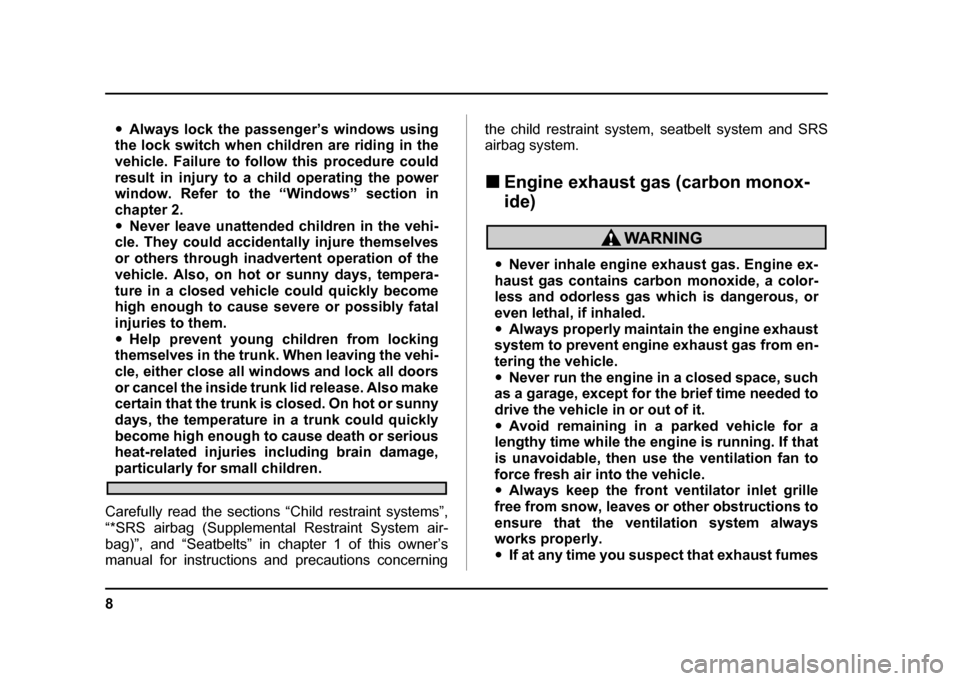
8
"Always lock the passenger’s windows using
the lock switch when children are riding in the
vehicle. Failure to follow this procedure could
result in injury to a child operating the power
window. Refer to the “Windows” section in
chapter 2." Never leave unattended children in the vehi-
cle. They could accidentally injure themselves
or others through inadvertent operation of the
vehicle. Also, on hot or sunny days, tempera-
ture in a closed vehicle could quickly become
high enough to cause severe or possibly fatal
injuries to them." Help prevent young children from locking
themselves in the trunk. When leaving the vehi-
cle, either close all windows and lock all doors
or cancel the inside trunk lid release. Also make
certain that the trunk is closed. On hot or sunny
days, the temperature in a trunk could quickly
become high enough to cause death or serious
heat-related injuries including brain damage,
particularly for small children.
Carefully read the sections “Child restraint systems”,
“*SRS airbag (Supplemental Restraint System air-
bag)”, and “Seatbelts” in chapter 1 of this owner’s
manual for instructions and precautions concerning the child restraint system, seatbelt system and SRS airbag system. !
Engine exhaust gas (carbon monox- ide)
"Never inhale engine exhaust gas. Engine ex-
haust gas contains carbon monoxide, a color-
less and odorless gas which is dangerous, or
even lethal, if inhaled." Always properly maintain the engine exhaust
system to prevent engine exhaust gas from en-
tering the vehicle." Never run the engine in a closed space, such
as a garage, except for the brief time needed to
drive the vehicle in or out of it." Avoid remaining in a parked vehicle for a
lengthy time while the engine is running. If that
is unavoidable, then use the ventilation fan to
force fresh air into the vehicle. " Always keep the front ventilator inlet grille
free from snow, leaves or other obstructions to
ensure that the ventilation system always
works properly. " If at any time you suspect that exhaust fumes
Page 14 of 491
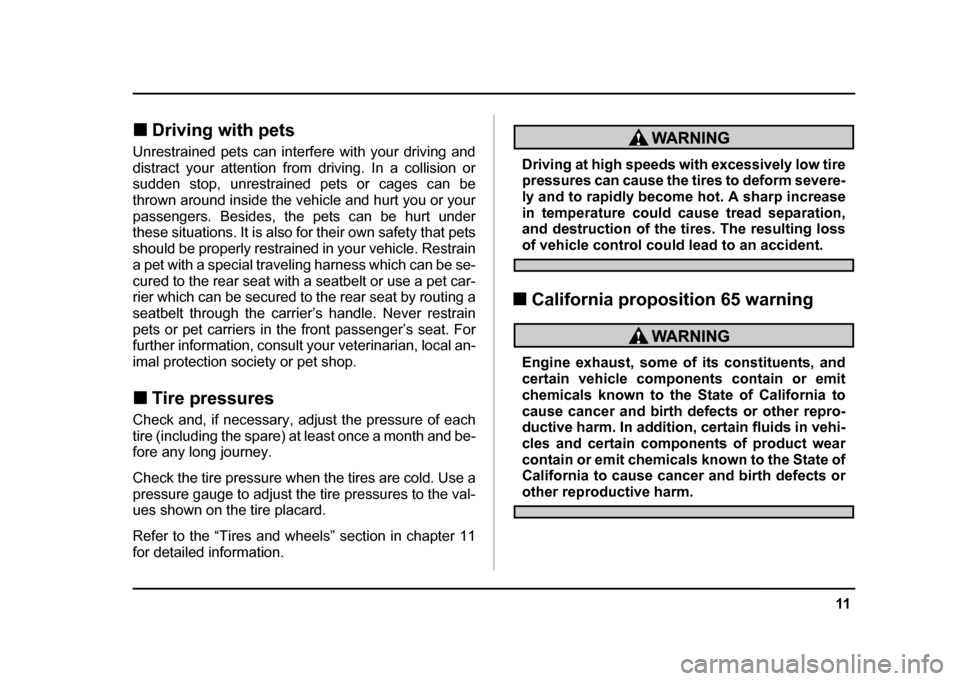
11
–
CONTINUED –
!Driving with pets
Unrestrained pets can interfere with your driving and
distract your attention from driving. In a collision or
sudden stop, unrestrained pets or cages can be
thrown around inside the vehicle and hurt you or your
passengers. Besides, the pets can be hurt under
these situations. It is also for their own safety that pets
should be properly restrained in your vehicle. Restrain
a pet with a special traveling harness which can be se-
cured to the rear seat with a seatbelt or use a pet car-
rier which can be secured to the rear seat by routing a
seatbelt through the carrier’s handle. Never restrain
pets or pet carriers in the front passenger’s seat. For
further information, consult your veterinarian, local an-
imal protection society or pet shop. ! Tire pressures
Check and, if necessary, adjust the pressure of each
tire (including the spare) at least once a month and be-
fore any long journey.
Check the tire pressure when the tires are cold. Use a
pressure gauge to adjust the tire pressures to the val-
ues shown on the tire placard.
Refer to the “Tires and wheels” section in chapter 11
for detailed information.
Driving at high speeds with excessively low tire
pressures can cause the tires to deform severe-
ly and to rapidly become hot. A sharp increase
in temperature could cause tread separation,
and destruction of the tires. The resulting loss
of vehicle control could lead to an accident.
! California proposition 65 warning
Engine exhaust, some of its constituents, and
certain vehicle components contain or emit
chemicals known to the State of California to
cause cancer and birth defects or other repro-
ductive harm. In addition, certain fluids in vehi-
cles and certain components of product wear
contain or emit chemicals known to the State of
California to cause cancer and birth defects or
other reproductive harm.
Page 17 of 491
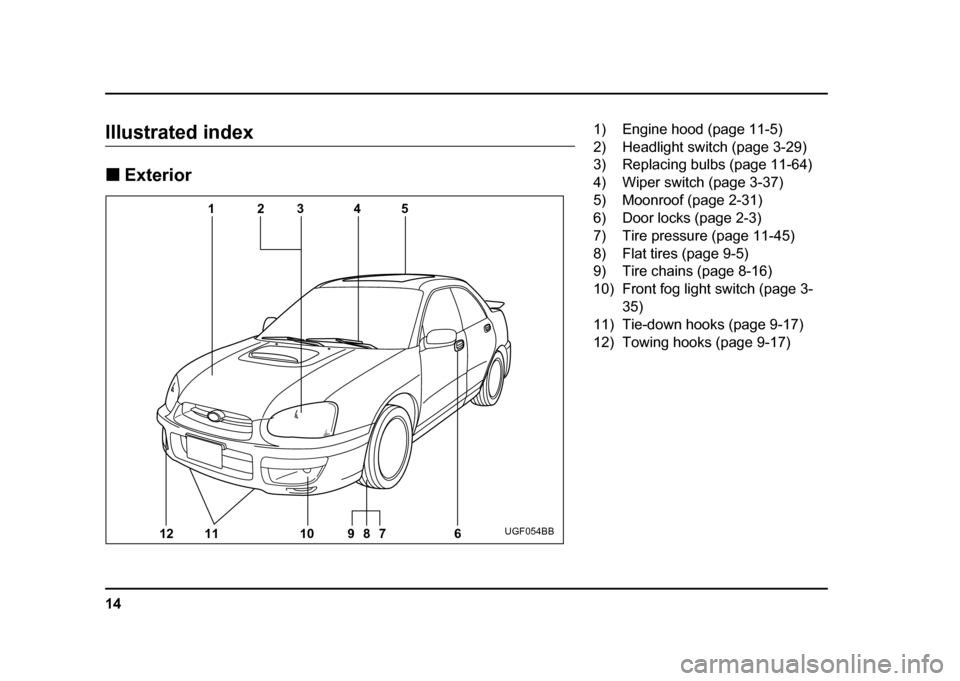
14
Illustrated index !Exterior
10
12 11 8 7 965
4
3
12UGF054BB
1) Engine hood (page 11-5)
2) Headlight switch (page 3-29)
3) Replacing bulbs (page 11-64)
4) Wiper switch (page 3-37)
5) Moonroof (page 2-31)
6) Door locks (page 2-3)
7) Tire pressure (page 11-45)
8) Flat tires (page 9-5)
9) Tire chains (page 8-16)
10) Front fog light switch (page 3-
35)
11) Tie-down hooks (page 9-17)
12) Towing hooks (page 9-17)
Page 26 of 491
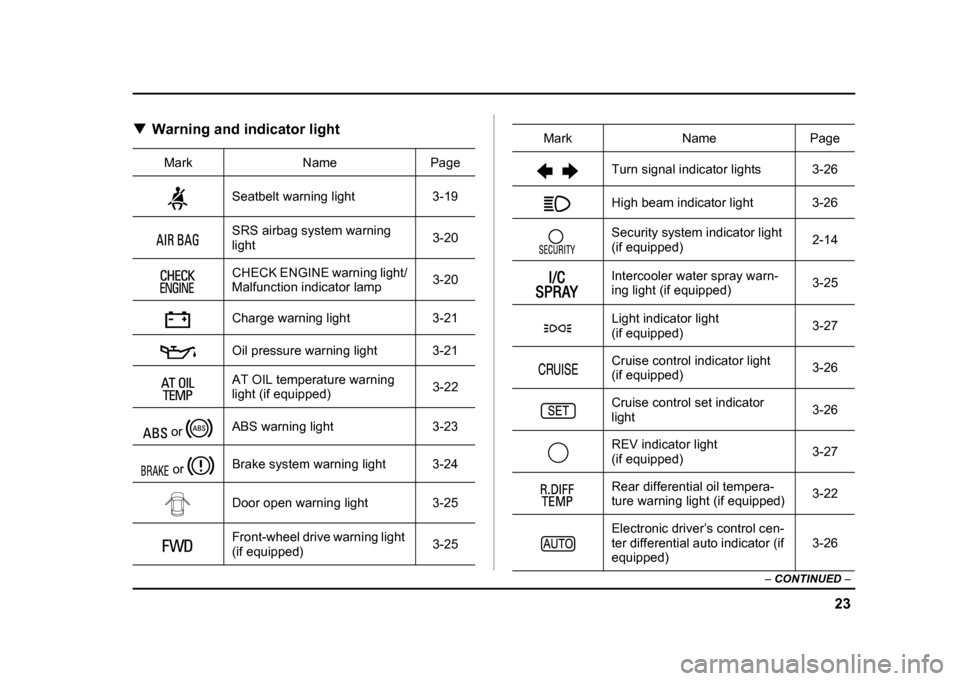
23
–
CONTINUED –
!Warning and indicator light
Mark Name Page
Seatbelt warning light 3-19
SRS airbag system warning light 3-20
CHECK ENGINE warning light/
Malfunction indicator lamp 3-20
Charge warning light 3-21
Oil pressure warning light 3-21
AT OIL temperature warning light (if equipped) 3-22
or ABS warning light 3-23
or Brake system warning light 3-24
Door open warning light 3-25
Front-wheel drive warning light
(if equipped) 3-25
Turn signal indicator lights 3-26
High beam indicator light 3-26
Security system indicator light (if equipped) 2-14
Intercooler water spray warn-
ing light (if equipped) 3-25
Light indicator light (if equipped) 3-27
Cruise control indicator light (if equipped) 3-26
Cruise control set indicator light 3-26
REV indicator light (if equipped) 3-27
Rear differential oil tempera-
ture warning light (if equipped) 3-22
Electronic driver’s control cen-
ter differential auto indicator (if equipped) 3-26
Mark Name Page
Page 35 of 491
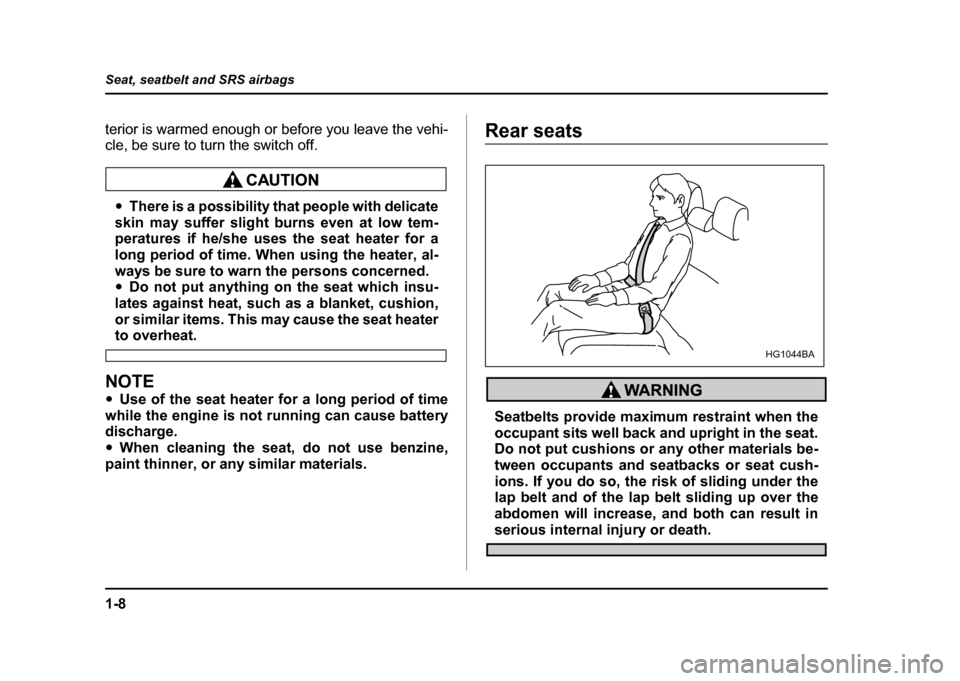
1-8
Seat, seatbelt and SRS airbags
terior is warmed enough or before you leave the vehi-
cle, be sure to turn the switch off.
"
There is a possibility that people with delicate
skin may suffer slight burns even at low tem-
peratures if he/she uses the seat heater for a
long period of time. When using the heater, al-
ways be sure to warn the persons concerned. " Do not put anything on the seat which insu-
lates against heat, such as a blanket, cushion,
or similar items. This may cause the seat heater
to overheat.
NOTE " Use of the seat heater for a long period of time
while the engine is not running can cause battery
discharge. " When cleaning the seat, do not use benzine,
paint thinner, or any similar materials.
Rear seats
Seatbelts provide maximum restraint when the
occupant sits well back and upright in the seat.
Do not put cushions or any other materials be-
tween occupants and seatbacks or seat cush-
ions. If you do so, the risk of sliding under the
lap belt and of the lap belt sliding up over the
abdomen will increase, and both can result in
serious internal injury or death.
HG1044BA